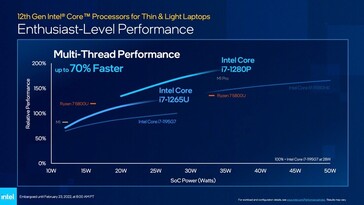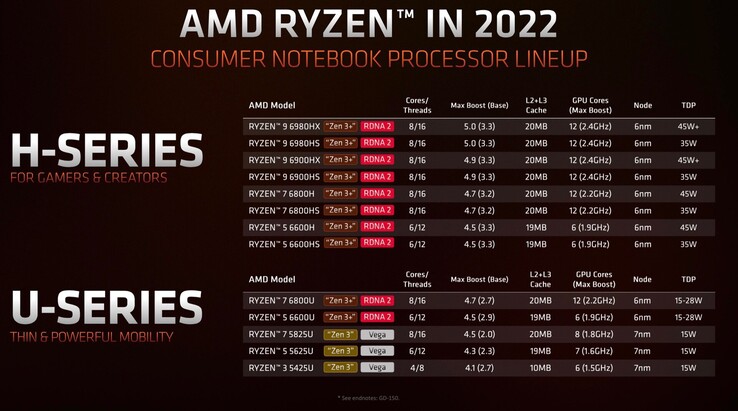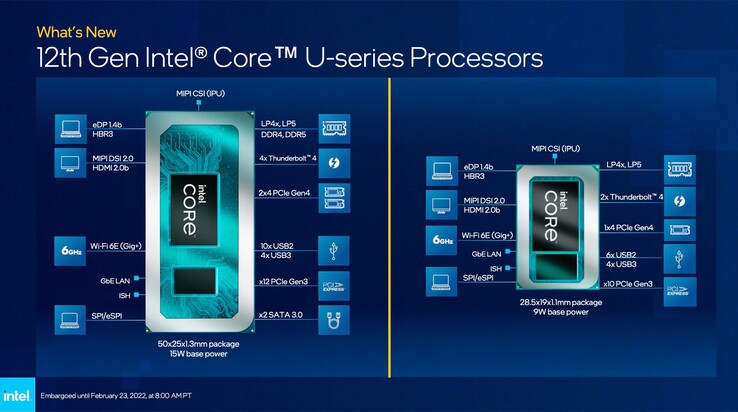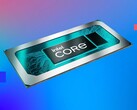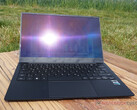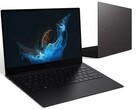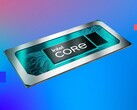After we took a closer look at the new Intel Core i7-1260P, we had the chance to review more new laptops with Intel’s new mobile CPUs and some of the results are surprising. We were worried that the actual performance only depends on the TDP configuration of each laptop and we were correct. Intel only specifies the maximum TDP power, so there can be massive performance differences even between two identical CPUs. The result so far is that the Core i5-1240P in the Lenovo Yoga Slim 7 Pro 14 (review will be published end of next week) is the most powerful Alder Lake-P chip we tested so far ahead of the Core i7-1260P and Core i7-1270P.
Is Alder Lake-P suited for compact notebooks?
We are used to the fact that TDP classifications from the manufacturer are just suggestions. The traditional U-series chips are usually set to around 30 Watts and some Core i7 CPUs from Intel scratched the 40W mark. Intel’s new Alder Lake-P chips have a nominal TDP of 28W with a maximum value of 64 Watt. The problem is that even the Core i5-1240P hits this 64W limitation, which means the Core i7 chips would require even more power at their full clock speeds, let alone the Core i7-1280P with two additional Performance cores. Unfortunately, we were not able to increase the TDP limit via Intel’s own Extreme Tuning Utility to check the maximum consumption.
This makes it really hard to classify the chips, because they can compete with traditional U-series CPUs, but some implementations are already in range of Intel’s own H-series CPUs like the Core i7-12700H.
Core i5-1240P vs. Core i7-1260P vs. Core i7-1270P
First, we want to take a look at the results of the three Alder Lake-P CPUs we tested so far in devices from Lenovo and Samsung, the Core i5-1240P, Core i7-1260P, and Core i7-1270P. All these CPUs share the same configuration with four Performance cores and eight efficiency cores. The difference is the respective core clock and the Core i5 is also equipped with the slower version of the Iris Xe Graphics G7 iGPU with 80 execution units. The laptops models show massive difference in terms of the implementations and the actual TDP values are listed in the following table:
| Test unit | CPU | Power Limit 2 | Power Limit 1 |
|---|---|---|---|
| Lenovo ThinkPad X1 Yoga G7 | Core i7-1270P | 64 Watts | 28 Watts |
| Lenovo Yoga 9i 14 | Core i7-1260P | 64 Watts | 38 Watts |
| Lenovo Yoga Slim 7 Pro 14 G7 | Core i5-1240P | 64 Watts | 50 Watts |
| Samsung Galaxy Book 2 Pro 13 | Core i5-1240P | 40 Watts | 20 Watts |
We use the Microsoft Surface Laptop Studio with the H35 chip Core i7-11370H for a Tiger Lake reference with comparable TDP settings (51/40W). The multi-core performance is obviously much better thanks to the increased number of cores/threads on Alder Lake-P.
However, it gets interesting when we compare the performance between the Yoga 9i 14 and the Yoga Slim 7 Pro 14. Despite the much higher sustained consumption (38 vs. 50W), the performance is actually almost identical. Of course, there can be slight variations between the chips, but it is clearly evident that the additional power does not result in much higher performance. The problem is therefore still the same, the 10nm chips are inefficient at high clocks.
The other extreme example is the Galaxy Book from Samsung, where the Core i5-1240P is operated at 20W pretty much all the time and the multi-core performance is just not competitive by any means. There is an extreme difference between these two models, even though the spec sheet suggests the same level of performance.
Cinebench R15 Multi Loop
We already mentioned the high single-core performance in our review of the Core i7-1260P, which is very good thanks to high Turbo clocks of Alder Lake-P, but this also requires a lot of power (up to 26W). But there can also be differences as shown by the ThinkPad X1 Yoga G7, where the Core i7-1270P consumes slightly less power and does not have an advantage over previous Tiger Lake chips in single-core applications (please see our comprehensive review for all the test results).
Alder Lake-P vs. Alder Lake-H
Intel’s current H-series CPUs can consume a lot of power for short periods, but they usually level off at much lower values. Dell’s new XPS 17 9720 is such an example where the CPU consumption is limited to 45W after a couple of minutes, so the consumption is actually lower compared to the Yoga Slim 7 Pro 14 with the Core i5-1240P. We also had the chance to test the Core i7-12700H fixed at 45W in the Alienware x14 due to a software bug. This comparison is very interesting, because the performance is similar in the first run (45W vs. 64W for Alder Lake-P), but it stays at this level and is better compared to the Alder Lake-P at 50W. The explanation is pretty simple, because the Core i7-12700H with two more P-cores has more cores running at a slightly lower clock rate, which is more efficient.
This behavior is also supported by the aforementioned Dell XPS 9720 with the Alder Lake-H Core i7-12700H. The device benefits from very high power limits at first (more than 100W), but eventually levels off at 45W after a couple of minutes, where the behavior is pretty much identical to the Alienware x14. The multi-core performance is once again better, despite the lower power consumption.
Cinebench R15 Multi Loop
Intel Alder Lake-P vs. AMD Ryzen 5000/6000
We are just getting the first laptops with the new U-series CPUs from the Ryzen 6000 generation, so we cannot yet offer a full analysis at this point. However, we can look at an older Ryzen 9 5900HS, which is operated at 42W in the case of the Lenovo Yoga Slim 7 Pro 14. Despite the lower consumption, the Ryzen 9 still offers better multi-core performance. AMD’s Zen 3 cores also perform well in single-core tests, especially considering the lower consumption (~17W).
We have initial benchmark results for the new Ryzen 7 6800U in our database, but the TDP limits are much lower at 30/17W. The initial results are still promising and the TDP values are better suited for compact devices. However, we are still waiting for more test results and data before we can give a comprehensive and serious comparison with Alder Lake-P including efficiency results.
Cinebench R15 Multi Loop
The challenges for the manufacturers
The high power consumption is also an issue for the manufacturers, because cooling solutions of compact laptops are often not designed to handle these consumption values, which is also the case for the power supply. Compact laptops are often shipped with 65W units, but this is insufficient if you really want to use the performance of the new processors. Lenovo’s Yoga Slim 7 Pro 14 with the Core i5-1240P is a good example for this problem, because the system has to utilize the battery power under load, which is not necessarily healthy for the battery in the long run.
The biggest issue for customers is the increased fan activity during everyday workloads, because the chips quickly reach high temperatures. The higher consumption also affects the battery runtime and our measurements so far show noticeable differences. The new ThinkPad X1 Yoga G7, for example, lasted about 3 hours shorter during our Wi-Fi test at 150 nits compared to its predecessor with a similar panel. We are pretty sure there will be some improvements with software updates over time, but we can definitely see a trend here.
Verdict - Alder Lake-P offers good performance, but is not very efficient
We were quite surprised by the high power consumption of the new Alder Lake-P mobile processors after we tested a couple of units. Even the Core i5-1240P runs into the 64W limitation, which begs the question: Do these chips make much sense in compact laptops? The performance is not bad by any means, but Alder Lake-P is still very inefficient at high Turbo clocks and it is hard to ignore the effects during everyday tasks (increased fan activity and shorter battery runtime). Customers do not get any indication of the performance when they buy a new laptop and one device with a Core i5 might offer more performance than another laptop with a more expensive Core i7, for example. Intel could have introduced TDP ranges, so customers could at least get an idea of the performance they pay for.
However, it can also happen that the performance of two identical chips is massively different. The Core i5-1240P in the Yoga Slim Pro 14 is one of the fastest Alder Lake-P chips so far, while the same Core i5-1240P in the Samsung Galaxy Book 2 Pro 13 at just 20W is just not competitive. This device should have been equipped with a slower U-series chip, but a P-series model like the Core i5-1240P obviously looks better on paper and suggests a higher level of performance.
Our initial results of the new AMD Ryzen 7 6800U are promising and once again show a very efficient CPU. However, it has much lower TDP limits, so the ideal comparison CPU would be an Alder Lake-U chip, even though Intel's maximum TDP number of 55W despite two fewer P-cores worries us a bit. We suspect the performance of the new U-series chips with just 2 P-cores will be much lower. But these are just speculations so far, there are just no suitable devices right now and it will probably take a couple of weeks/months based on our information.
Please see our comprehensive review of Alder Lake-P laptops for more data and benchmarks results. Right now, we are working on our reviews of the Lenovo Yoga Slim 7 Pro 14 with the Core i5-1240P and the Asus Zenbook S13 OLED with the AMD Ryzen 7 6800U, which will be published sometime next week.


 Deutsch
Deutsch English
English Español
Español Français
Français Italiano
Italiano Nederlands
Nederlands Polski
Polski Português
Português Русский
Русский Türkçe
Türkçe Svenska
Svenska Chinese
Chinese Magyar
Magyar

